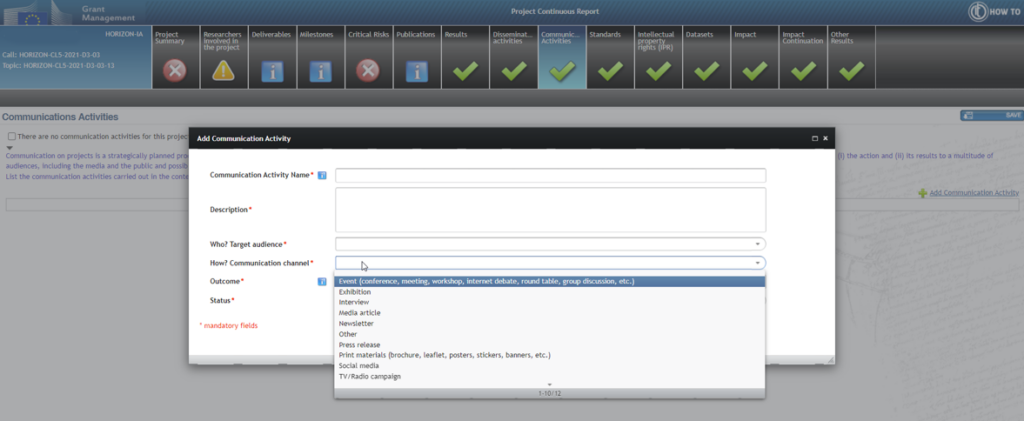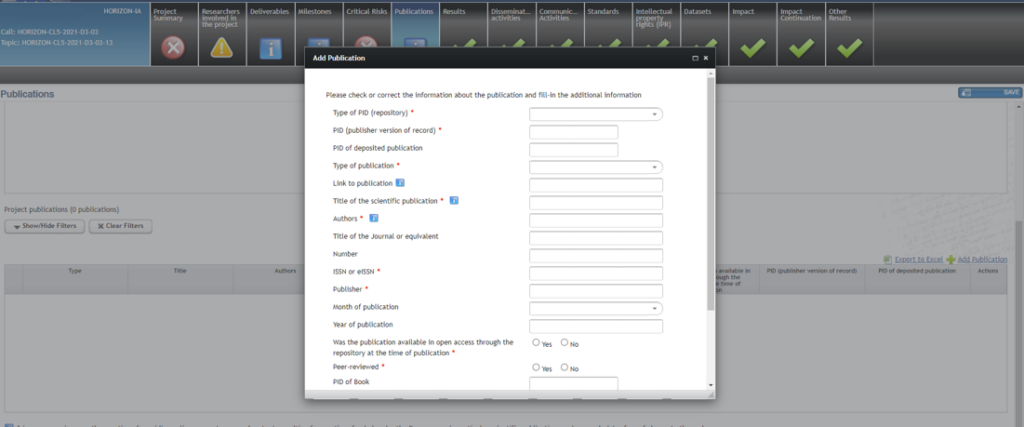Making outreach reporting easier – the importance of continuous monitoring
25th June 2024 at 4:19 pm
Continuous vs periodic reporting – why embrace both?
Welcome back to our blog post series dedicated to periodic reports (RPs) where today we focus on reporting about communication, dissemination and exploitation activities. Just to remind you, reporting on these activities is mandatory in the European Union–funded projects and requires entering a lot of data into the Funding and Tenders portal. This includes detailed information on conference participation, publications, media coverage but also on datasets and online presence, like website and social media. Without continuous monitoring, namely the constant tracking and assessment of your outreach activities, you risk finding yourself at a loss when the reporting period comes. To help you mitigate that risk, we are sharing our best practices in the following paragraphs.
Why can continuous monitoring save you time?
Continuous monitoring of communication and dissemination efforts is important for several reasons. Firstly, implementation of these activities and reporting on their delivery is a requirement by the European Commission (EC), outlined as a contractual obligation in the Grant Agreement. This ensures that projects remain accountable and aligned with their stated objectives. Continuous monitoring allows for the early identification of issues, enabling consortia to adjust strategies promptly. It also enhances transparency and accountability, providing clear evidence of the project’s progress and outreach. Last, but not least tracking your communication and dissemination activities throughout the project helps streamline periodic reporting, as activities are already documented reducing the administrative burden when filling in the required information in the EU Funding & Tenders Portal.
What do you report and how do you monitor your activities?
From our previous blog post on “Effective Reporting in Horizon Europe: Communication, Dissemination and Exploitation” you learn that there are two components, where you must report on the project outreach to the EU. In part A, the project-specific online forms, you must provide detailed information as shown in the visual below. When not done continuously, filling in data in the EU portal might become challenging in terms of complexity and time effort.



Next to filling in the information in the EU portal, you must also provide an account of activities and their status in Part B, the Technical Report. To effectively report on communication and dissemination activities in both components of the PRs, however, several key elements should be tracked continuously throughout the project. These include the type of activity (e.g., website, social media campaigns, media articles, publications, conferences, cross-project collaboration), the objectives (e.g., raising awareness, engaging stakeholders, sharing results), stakeholders addressed, and reach. Various tools and techniques can facilitate this monitoring. For example, Google Analytics can provide insights into website performance, while social media analytics engines track engagement on various platforms. Surveys and direct feedback mechanisms further enrich the data, offering a comprehensive view of the communication and dissemination efforts’ effectiveness.
What are the common challenges and best practices to overcome these?
Despite its importance, continuous monitoring can present several challenges. Research projects often involve multiple partners, each with different resource constraints. Varying levels of involvement in outreach activities can also make coordinating monitoring efforts complex. This can lead to difficulties in ensuring the accuracy of collected information when reporting to the EU. It is also worth noting that Google Analytics and some social media platforms offer data on the channel performance only within specific time frames, posing a risk of data loss if not tracked continuously. Using integrated tools that consolidate data from various sources can streamline the process and improve collaboration when the periodic report is due. Including an experienced partner in the consortium who can lead communication and dissemination activities and support accurate reporting is highly beneficial.

From our extensive collaborations in numerous Horizon2020 and Horizon Europe projects, over the years, we have defined best practices for effective continuous monitoring and periodic reporting, making it easier for academic and industrial partners. Defining processes and responsibilities is a good start. If not yet clear, defining a dedicated person responsible for monitoring the activities will ensure consistency and lead project partners into smooth reporting periods. To this end, providing advice, instructions and supportive tools to facilitate the collection of various information required by the EC can also ease the administrative burden. For instance, accelCOCKPIT® Project Communications developed by accelopment is successfully used in many EU-funded projects. This customised and comprehensive tool enables the tracking of communication and dissemination activities related to the project, facilitates their assessment, and helps in planning corrective measures. The core parts of the tool align with the EU Funding and Tenders Portal, making it easy to collect the information required for periodic reporting from different partners. Moreover, accelCOCKPIT® Project Communications integrates data streams from different sources, including partners’ input, Google Analytics, social media analytics engines, relevant online management platforms, and direct feedback from stakeholders. This automated integration not only streamlines data collection but also supports continuous reporting to the EU and enhances the assessment of outreach activities, aiding in the development of intermediate impact reports or technical reports.
Do you need support?
Implementing best practices and insights from other projects for continuous monitoring and reporting can not only ease the process but also improve the effectiveness of communication and dissemination activities. With a dedicated team of professionals, we provide essential support to consortia during the planning, implementation, monitoring, and evaluation stages. By navigating the complex requirements established by the EU, we guide project partners through the reporting process, ensuring it progresses smoothly and efficiently. If you are interested in learning more about how we can support your project in these areas, please do not hesitate to contact our team.

Joanna Plesniak
Project Manager Communications

Miriam Frances
Project Manager Communications
